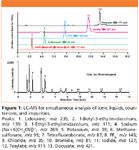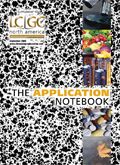LC–MS Analysis of Ionic Liquids, Counterions, and Impurities Using the Trimode Acclaim Trinity P1 Column
The term ionic liquid refers to organic salts with relatively low melting points (below 100 °C) that usually consist of an organic cation or anion and a counterion, in either organic or inorganic form.
The term ionic liquid refers to organic salts with relatively low melting points (below 100 °C) that usually consist of an organic cation or anion and a counterion, in either organic or inorganic form. Ionic liquids exhibit unique characteristics such as extremely low vapor pressure, excellent thermal stability, electrical conductivity, a high degree of polarity, and miscibility with various types of solvents. Ionic liquids have been used as catalysts and solvents in organic chemistry and electrochemistry, and as mobile phase modifiers or functionalized stationary phases in separation science (1–3).
Analytical methods for ionic liquid characterization are challenging due to the complexity of the cationic or anionic organic ions, counterions, and ionic impurities. Ion chromatography (IC), liquid chromatography (LC), and hydrophilic interaction chromatography (HILIC) have been used for ionic liquid analysis, featuring ion-exchange or reversed-phase columns (4–6).
This study describes the first LC–MS method for the simultaneous analysis of ionic liquids, counterions, and halide impurities in a single chromatographic run on an Acclaim® Trinity™ P1 trimode column, using mass spectrometry to ensure selective and sensitive detection.
The experiment was performed on an LC–MS system consisting of an UltiMate® 3000 HPLC system coupled to a MSQ Plus™ single quadrupole mass spectrometer with electrospray ionization interface. Chromatographic separation was achieved on an Acclaim Trinity P1 column (2.1 × 100 mm, 3 μm) with a gradient elution: A: acetonitrile; B: 100 mM ammonium acetate, pH 5.2; C: DI water. B was kept constant at 5%, A was increased from 55% (2 min) to 60% in 8 min then 90% in 1 min and kept at 90% for 7 min.
MSQ Plus was operated in selected ion monitoring (SIM) mode and probe temperature was set at 500 °C, nitrogen was used as nebulizer gas at 85 psi and needle voltage was set at 1 kV.
As shown in Figure 1, ionic liquids, counterions, and impurities were chromatographically separated on the Acclaim Trinity trimode column. Analytes were eluted in groups in the following order: organic cations, inorganic cations, inorganic anions, and organic anions. The upper traces in Figure 1 show the SIM chromatograms of selected analytes, illustrating the specificity and selectivity of the MSQ Plus detector.

Figure 1
Conclusion
This study demonstrates the unique properties and superior chromatographic performance of the Acclaim Trinity trimode column and its application for simultaneous analysis of ionic liquids, counterions, and impurities. This method can be used for ionic liquid quality assurance, contamination analysis, and residue assessment of any removal process.
References
(1) Z. Yang and W. Pan, Enzyme and Microbial Tech. 37, 19–28 (2005).
(2) C. B. Marisa, G. E. Russell, and G. C. Richard, Chem. Phys. Chem. 5, 1106–1120 (2004).
(3) J. L. Anderson and D. W. Armstrong, Anal. Chem. 75, 4851–4858 (2003).
(4) A. Stojanovic, et al., J. Chromatogr., A 1209, 179–187 (2008).
(5) G. Le Rouzo, et al., J. Chromatogr., A 1164, 139–144 (2007).
(6) F. Hao, P. R. Haddad, and T. Ruther, Chromatographia 495–498 (2008).
Trinity is a trademark and Acclaim and UltiMate are registered trademarks of Dionex Corporation.
MSQ Plus is a trademark of Thermo Fisher Scientific, Inc.

Dionex Corporation
1228 Titan Way, P.O. Box 3603, Sunnyvale, CA 94088
tel. (408)737-0700; fax (408)730-9403
Website: www.dionex.com

Free Poster: NDSRI Risk Assessment and Trace-Level Analysis of N-Nitrosamines
April 25th 2025With increasing concern over genotoxic nitrosamine contaminants, regulatory bodies like the FDA and EMA have introduced strict guidelines following several high-profile drug recalls. This poster showcases a case study where LGC and Waters developed a UPLC/MS/MS method for quantifying trace levels of N-nitroso-sertraline in sertraline using Waters mass spectrometry and LGC reference standards.
New TRC Facility Accelerates Innovation and Delivery
April 25th 2025We’ve expanded our capabilities with a state-of-the-art, 200,000 sq ft TRC facility in Toronto, completed in 2024 and staffed by over 100 PhD- and MSc-level scientists. This investment enables the development of more innovative compounds, a broader catalogue and custom offering, and streamlined operations for faster delivery. • Our extensive range of over 100,000 high-quality research chemicals—including APIs, metabolites, and impurities in both native and stable isotope-labelled forms—provides essential tools for uncovering molecular disease mechanisms and exploring new opportunities for therapeutic intervention.
New Guide: Characterising Impurity Standards – What Defines “Good Enough?”
April 25th 2025Impurity reference standards (IRSs) are essential for accurately identifying and quantifying impurities in pharmaceutical development and manufacturing. Yet, with limited regulatory guidance on how much characterisation is truly required for different applications, selecting the right standard can be challenging. To help, LGC has developed a new interactive multimedia guide, packed with expert insights to support your decision-making and give you greater confidence when choosing the right IRS for your specific needs.
Using the Carcinogenic Potency Categorisation Approach (CPCA) to Classify N-nitrosamine Impurities
April 25th 2025Learn how to manage nitrosamine impurities in pharmaceuticals with our free infographic. Discover how the CPCA approach establishes acceptable intake limits and guides the selection of NDSRI reference samples. Stay compliant and ensure safety with our ISO-accredited standards.

.png&w=3840&q=75)

.png&w=3840&q=75)



.png&w=3840&q=75)



.png&w=3840&q=75)














